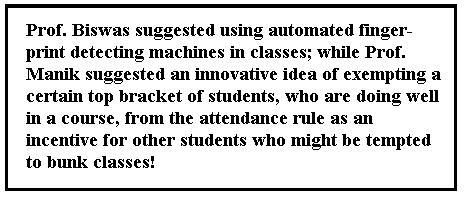To bunk or not to bunk
Ever wondered why we are made to attend 80% of the lectures? Was it always so? Is it only enforced at IITB or other IITs and other universities too? Devasheesh and Palak explore the answers to these questions.
As we sat at the Shack sipping coffee and cursing classes, we remembered an interesting incident which had occurred in our second year. The professor taking a mechanical engineering course for metallurgical engineering students came to the last class looking really distraught. This was his complaint: “I was compiling the list of students who have low attendance and I am confused about whether to give them XX or not. To my surprise, most of them have a much better performance than the ones who have high attendance. It’s the first time I’ve seen this and I’m baffled!”
This led us to wonder what brought about the 80% attendance rule in the first place, whether it really led to better academic performance and whether it is still useful. We talked to a few professors to find out. Here’s the saga of the 80% attendance rule.
Prof. N. Ballal from the Department of Material Science, who has been at the helm of things for a long time, and was a senate member during the late 80’s when the erstwhile senate enforced this rule, remembers that when the rule was put into place a strong correlation was observed between the attendance of the students and their performance. Within one or two years of enforcing this rule, the number of students whose degrees had to be terminated due to poor performance decreased drastically. The immediate results of the rule were so impressive that it has remained in place since then.
Prof. Ballal explains that the rationale behind introducing the rule was two-fold. Firstly, since IITs are residential campuses, the students should be answerable for their whereabouts during class hours. And the second and more fundamental reason is the educational system here in India. In India, if a student is kicked out of the institute after his/her first year, his time has been wasted. Whereas, in the U.S., for example, a person can carry over his/her degree courses to a different university without repeating the courses he/she has done. This puts a greater responsibility on the authorities here to monitor students’ academic activities – especially those of the weaker students. He further adds that, unlike the trend here, where parents support students up till their graduation, most of the students abroad pay for their own education, and are hence a lot more responsible. He wonders whether letting the students earn on the campus itself might help loosen the belt a little. He also brings to notice the fact that the enforcement was done in consultation with the student representatives at that time.
Prof. Anurag Mehra from the Department of Chemical Engineering does not believe that an attendance rule should be enforced; if there are students who can manage to do well by having less than the mandatory level of attendance, he doesn’t have a problem. However, he says, it is important that a regulatory framework be in place so that students can then decide for themselves how much attendance and self-study they should put in. A few surprise quizzes and random attendance, say, once a week serves as a good framework for keeping students ‘interested(!)’. He said that, though most of the professors in IIT are liberal in their outlook about such issues, they have to show some respect for the conservative expectations that parents of, perhaps, a significant number of students harbor: of looking after their wards like surrogate parents. Taking attendance sometimes, he felt, as did Prof. D. Manik (Mechanical Engineering), gives the data and the confidence to the faculty so that they can answer the parents in case of any confrontation as to whether or not the student was spending his lecture hours elsewhere.Most of the professors we interviewed agreed that IITB must not blatantly imitate the U.S. varsity system and should rather develop its own structure based on India’s social and economic system. Added to that are the changing preferences and motivations of the students. While Prof. Mehra makes a comparison between the students here and the students at IIM or US universities and observes that under-graduates here are much less motivated towards academics, thus making this rule a good check, Prof. P. Seshu from Mechanical Engineering totally disagrees with the view that the motivation or perceptions of students towards their departments could really be related to low attendance or, for that matter, corrected through just monitoring of attendance.
Prof. S. Biswas of the Computer Science Department, on the other hand, believes that it is not motivation levels or social settings that make the rule relevant – it is the course structure at IITB. He holds that a student has to be introduced to a topic within a certain number of classes (maybe with the exception of first year courses), and to perform well in the course, a student has to take at least 80% of the lectures. He believes if a good number of students are managing to do well without fulfilling the minimum criterion of attendance, then the course content needs to be revised!
In spite of that, some professors have observed that there isn’t any direct correlation between the attendance and performance of a student in a course, since most students have found out easier or smarter ways to crack exams. This has in fact sprouted other problems like giving proxy attendance and has led to a change in the priority of professors from just monitoring attendance to monitoring attendance in a foolproof way. Some professors have stopped taking attendance, some take surprise quizzes while others make students mark their own attendance and sign a declaration about their honesty! Prof. Biswas, who is also the Dean, A.P., suggested using automated finger-print detecting machines in classes; while Prof. Manik suggested an innovative idea of exempting a certain top bracket of students, who are doing well in a course, from the attendance rule as an incentive for other students who might be tempted to bunk classes!
In conclusion, most of the professors agree that, while the imposition of a minimum attendance requirement might not be the best solution to some of the problems faced by the IIT system today, it does help keep a check on the borderline students who might fall out otherwise. Till someone figures out a solution which suits all, good students would be expected to be present at the front benches; if not always, at least 80% of the time!
Devasheesh Mathur and Palak Ambwani are final year Dual Degree students from the MEMS Department. They can be contacted at devasheesh_mathur@iitb.ac.in and palak_a@iitb.ac.in.

